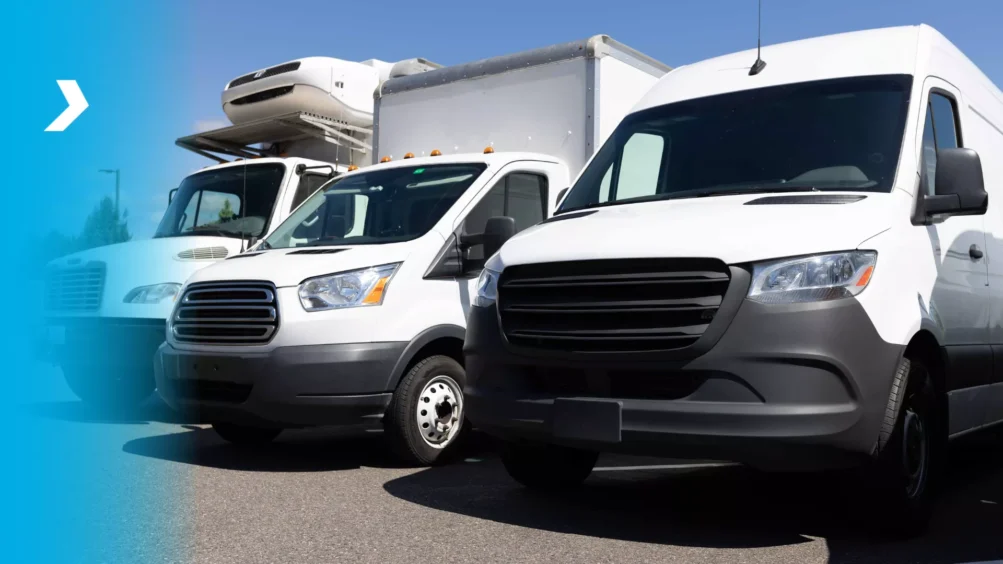
Small Trucks vs. Semi Trucks: 8 Reasons to Choose STL
The larger the truck, the greater its benefits? The truth is that this math only works for huge amounts of cargo, and it completely crashes against the wall of inefficiency and higher costs when your load is easy to rest on up to 14 pallets.
If your load is compact enough to take the space of 3 to 14 pallets, hiring a semi-truck with its higher fuel consumption and more expensive maintenance is inefficient in light of not only cost efficiency but also the time in transit. Overall, there are at least eight reasons to choose STL over FTL for your delivery.
Ability to Reach and Maneuver through Urban Environments
Cargo vans, box trucks, and straight trucks, with their smaller size and superior maneuverability, are easier to navigate through narrow streets, congested urban environments, and residential neighborhoods. They are ideal not only for last-mile deliveries but also for long rips through densely populated areas where larger trucks struggle to operate efficiently. According to the Urban Institute’s report, these smaller vehicles can reduce delivery times by 25% in urban settings due to their ability to access restricted areas.
Commercial vans also shine when it comes to loading and unloading times. They can fit into smaller parking spaces and get closer to loading docks or delivery entrances, streamlining the loading and unloading process and reducing the overall time spent off the road. This efficiency is especially beneficial for businesses operating in tight urban spaces where parking is at a premium and time is of the essence.
Cost-Effectiveness You Can Count per Mile
Commercial vans generally offer superior fuel efficiency compared to semi-trucks. On average, commercial vans achieve around 20 miles per gallon, whereas semi-trucks typically reach only about 6 miles per gallon. This difference translates into substantial fuel cost savings, particularly over long distances and frequent deliveries.
Beyond fuel savings, small commercial vans also benefit from lower maintenance and insurance costs compared to semi-trucks. The simpler mechanics and smaller size of vans result in less expensive and more straightforward maintenance procedures. Thus, based on a report by the American Transportation Research Institute (ATRI), the annual maintenance cost for a commercial van is roughly $4,000, whereas a semi-truck can incur expenses upwards of $15,000. Moreover, insurance premiums for vans are generally lower due to their smaller size and reduced risk profile, costing up to 30% less than insuring a semi-truck.
Limits and Restrictions? No Problem!
Due to their weight and size, semi-trucks often face limitations on certain roads and bridges, requiring special permits and additional planning. On the other hand, commercial vans are less likely to exceed these restrictions, reducing the administrative burden and the risk of fines and saving logistics companies both time and money.
The smaller size of commercial vans allows for greater route flexibility. Unlike semi-trucks, which are often restricted from using certain roads due to their weight and size, vans can navigate a wider range of routes. This flexibility enables them to take more direct paths to their destinations, reducing both travel time and distance and resulting in up to 15-20% savings for urban deliveries.
Unmatched Speed and Agility
Commercial vans excel in providing quick deliveries. Their compact size allows them to take more direct paths and navigate through traffic more effectively than larger trucks, reducing delivery times by up to 20%. Besides, they do not fall under strict speed limits, which is common when driving full-size trucks.
Vans are kings of last-mile delivery. This last mile is often the most complex and time-consuming part of the delivery process, yet also the most important for the customer. Thanks to their size and agility, vans can easily handle the demands of last-mile deliveries, reaching residential areas and urban centers.
Less Environmental Impact
Smaller, more fuel-efficient small commercial vans and trucks produce significantly fewer emissions than semi-trucks. Thus, according to the Environmental Protection Agency, small commercial vans emit roughly 30% less CO2 per mile compared to semi-trucks, outperforming them in carbon footprint reductions.
The global shift towards electric commercial vans, which are primarily lightweight trucks, makes the right-size small trucks an even greener alternative to traditional fuel-powered vehicles. The International Energy Agency projects that the number of such electric vans on the road will increase tenfold by 2030.
Versatility You Can’t but Like
Sprinters, cargo vans, and straight trucks are extremely versatile and capable of transporting a wide range of cargo types. From small parcels to perishable goods, these vehicles can handle just about any load. This adaptability is a valuable asset for e-commerce, food delivery, healthcare, and other critical sensors.
Vans can be outfitted with shelving, refrigeration units, and other modifications to ensure that goods are transported safely and efficiently. The interior design of commercial vans can also be optimized for efficient space utilization with adjustable shelving and secure storage compartments, allowing businesses to maximize the carrying capacity of their vans without compromising on safety. This customization capability enables companies to tailor their vehicles to different types of deliveries, enhancing service quality and customer satisfaction.

Reduced Infrastructure Strain
Thanks to their lighter weight, commercial vans exert less strain on public infrastructure compared to heavy semi-trucks, which cause significantly more wear and tear on road surfaces. In the long run, this translates to lower maintenance costs for public roads and bridges and an extended lifespan of infrastructure. As per the American Society of Civil Engineers, maintaining and repairing roads damaged by heavy trucks costs billions of dollars annually, so by using lighter vehicles like commercial vans, you help governments free up public funds for other essential services and improvements.
Not obvious at first sight, but commercial vans also benefit communities by minimizing disruptions due to road maintenance and repairs. Frequent roadworks caused by heavy weights lead to traffic congestion and delays, affecting both businesses and residents. By choosing lighter vehicles for deliveries, logistics companies help decrease the frequency of these disruptions, promoting smoother traffic flow and improved quality of life for community members.
Regulatory Advantages
The Federal Motor Carrier Safety Administration (FMCSA) mandates strict rules for semi-truck drivers to ensure safety and reduce fatigue, typically limiting drivers to 11 hours of driving within a 14-hour workday. Unlike them, drivers of smaller commercial vans often face fewer or even no restrictions, allowing for more flexible scheduling and increased operational efficiency. Drivers of small commercial vehicles do not have to report their driving time, enjoying more freedom in choosing their working hours, which often becomes a key factor for successfully meeting the timelines of time-sensitive and expedited deliveries.
Lighter regulations for commercial van drivers mean that logistics companies can better adapt to fluctuating delivery demands, which is particularly beneficial for businesses requiring rapid response times and last-minute schedule changes. Fewer restrictions on driving hours also mean that companies can optimize driver schedules without incurring additional compliance costs.
Conclusion
Back to the initial question, small commercial vans offer numerous advantages over semi-trucks when transporting 3-14 pallets. Running the gamut from cost-efficiency and operational flexibility to reduced delivery times and environmental advantages, they make cargo vans, box trucks, and straight trucks an ideal choice for modern logistics operations.
Looking for the right-sized truck for your shipment? Don’t settle for a compromise. Choose a recognized leader in STL logistics – America’s largest small truck network – Expedite All. Contact us today to experience the benefits of STL and see the difference it can make for your business.
You May Be Interested In
Air Freight vs. STL: Why Choose Small Truckload
Explains Mike Ernst, COO at Expedite All Air freight has long been considered the go-to for speedy deliveries. However, has it actually been so? Let’s compare air freight to a modern solution – Small Truckloads to find out which shipping method would win the battle. The Hidden Challenges of Air Freight Air freight might seem […]
Understanding Last-Mile Delivery: Why It’s Crucial and How Companies Optimize It
Last-mile delivery represents the shortest yet the most critical component of the modern supply chain. It is the final step of the product journey, from a distribution center to the customer’s doorstep, which can make or break the customer experience.